|
|
General: BANDERA MEXICANA (JACHIN-BOAZ Y SERPIENTE EN EL CENTRO)=$=DOLAR=TRANSFIGURACION
Elegir otro panel de mensajes |
|
|
Mensaje de Teotihuacán para el 8 del septiembre ....Arqueoastronomía de los Dioses
En la epoca prehispanica Cholula era considerada un centro cultural y religioso tan importante como lo seria en la actualidad Chalma, Juquila o la Basilica de Guadalupe. Los guardianes a quienes estaban dedicados estos centros eran Quetzalcoatl "Señor de los comerciantes y mercaderes" y Chiconauhquiauhitl "Señor de las nueve lluvias"; los cuales substituyeron los frailes franciscanos por la Virgen de los Remedios quedando la fecha de celebración de fiesta de honor a ambos el mismo dia, es decir el 8 de septiembre.
Para tal efecto se acostumbraba a que la gente de los pueblos llegaran desde lejos y gracias a la importancia de dichos Guardianes o Señores era necesario que por lo menos una vez en su vida visitaran el lugar. Este viaje se hcia como ofrenda y todo este ritual era acompañado de musica. Tambien aprovechaban para realizar el cambio de bastones de mando los cuales podrian compararse con los cetros que en la actualidad llevan los mayordomos (persona que se encarga del cuidado del santo de la localidad). Al ser lugares tan lejanos trian consigo los productos que elaboraban y los intercambiaban con otros pueblos, el cambio era producto por producto, llevaban a cabo el trueque.
Cholula se convierte en el centro religioso más importante del valle Poblano Tlaxcalteca , por lo que fue llamada "LA CIUDAD SAGRADA DE CHOLULA".
La pirámide de Cholula está orientada con respecto a los cuatro puntos cardinales que de acuerdo con las creencias de la cultura náhuatl representa los seis rumbos o regiones del mundo :
- MICTLAMPA. (Al norte) A este rumbo se le relación con el color negro . Es el lugar de los muertos donde van los elegidos de Tonatiuh . Lugar de Mitlancihuatl y Mitlantecutli.
- HUITZTLAMPA(al sur) Lugar de Huitzilopochtli , que representa la fuerza de voluntad . Se asocia este rumbo con el color azul.
- TLAHUISTLAMPA(al oriente). Es el rumbo de luz en donde se halla Quetzalcoatl , el dios de la inteligencia , asociado al color blanco .
- CIHUATLAMPA.(al poniente) Lugar de Xipetoctec "El descarnado" (dios de la creatividad y de las mujeres guerreras muertas en el parto). Asociado este rumbo con el color rojo .
- TONALTLAMPA . (Arriba en los cielos) Donde está el dador de la energía Tonatiuh.
- TLALITLAMPA . Abajo donde se halla Tonantzin , la diosa de la tierra , de la fertilidad . Se tiene conocimiento de que el templo de Quetzalcóatl se hallaba donde actualmente está la Capilla Real .
Sobre la gran pirámide se encontró la imagen de CHICOMENAUHIQUIAHUITL , la diosa de las nueve lluvias ; a la que le ofrecían sacrificio de infantes para solicitar lluvias en las épocas en las que se cargaba la sequía , dicha imagen fue sustituída por la Virgen de Los Remedios , cuya fiesta se celebra año con año el 1° de Septiembre . Actualmente podemos admirar una iglesia sobre la cúspide de la gran pirámide que se puede interpretar como "el triunfo de la fé católica sobre la idolatría".
En la actualidad los festejos comienzan desde los primeros dias del mes de agosto siguiendo el orden de la organizacion de circular, se ofician diariamente misas costeadas por barrios, pueblos, cofradias, hermandades, sindicatos, gremios, empresas industriales, empresas comerciales, devotos y particulares, cuando es el turno de los pueblos y barrios suben con su Santo. Dichas celebraciones se prolongan hasta el 8 de Septiembre.
En la noche del 31 de Agosto se realiza "La Procesión de los Faroles" la cual consiste en un recorrido por las calles de la ciudad en la que articipan los barrios con su respectiva imagen y las imagenes de "La Circular", esta procesión tiene más de 20 años de llevarse a cabo.Hacia las 2 de la madrugada se entonan "Las Mañanitas" y durante toda la noche se realizan misas que son donadas por diversas organizaciones y feligreses, a la una de la trade del primero de Septiembre se oficia la misa solemne de los pueblos y barrios, a la que asisten para alumbrar todos los mayordomos y fiscales entre quienes se reparten el costo de la ceremonia. El 8 de Septiembre se hacen diversas misas, y como sucedía en l aepoca prehispanica, gente de diversos lugares llega a venerar y mostrarle su agradecimiento a la Virgen de los Remedios. Al bajar del "cerro" aprovechan para vender o en su defecto llevar a cabo el tradicional y ancestral trueque sobre la explanada de la Plaza de la Concordia, frente a las majestuosas 44 arcadas del portal de peregrinos. Entre los productos que podemos encontrar estan: charales blancos, carpas, quesos de Chautla, hierbas de olor y medicinales, resinas, mecapales, acocotes, vainas, azafran, cacahuates, nueces y frutas de varios lugares como San Martín, Huejotzingo y Zacatlan, además de diversos productos artesanales y decorativos como petates, chiquihuites de vara, canastas, ollas de barro, utensilios de madera, etc.
El barrio de Santa María Xixitla es el barrio que le toca subir y hacer su misa el dia 8, dicho barrio además de hacer su misa realiza "el cambio de varas de mando", es decir el cambio de mayordomo del barrio y en lugar de traer una persona para sacrificar suben al "cerro" un "panzón" que es un muñeco hecho de papel de china y cohetes que tiene dentro manzanas las cuales caen de su "panza" al finalizar su quema. Este muñeco una vez quemado es bajado y llevado hasta el barrio por las personas que se encargarán de recolectar el dinero que se necesita para su elaboración para el año siguiente
De acuerdo con la tradición religiosa de nuestro país, la Virgen del Valle es considerada como la patrona del oriente de Venezuela, siendo venerada con especial devoción en la isla de Margarita. Cada 8 de septiembre se celebra su día, fecha en la que acuden miles de peregrinos a venerarla en su santuario ubicado en el Valle de Margarita, cerca de Porlamar. Las festividades duran varios días y, en cada uno de ellos, la Virgen luce un bello traje diseñado con las telas suministradas por sus devotos.
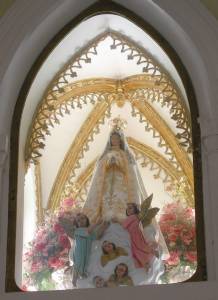
En los inicios de la conquista los españoles fundaron en la isla de Cubagua, la ciudad de Nueva Cádiz. En poco tiempo dicha ciudad creció vertiginosamente derivado de la extracción de perlas que abundaban en sus mares. Durante este período los habitantes de Nueva Cádiz encargaron a España una imagen de la Inmaculada Concepción para poner la ciudad bajo su protección. La imagen llegó a Cubagua en el año 1530, pero pocos años después, el 25 de diciembre de 1541, un huracán arrasó Nueva Cádiz y con ella la iglesia donde estaba la imagen de la Virgen. Al salvarse milagrosamente la imagen de la Virgen, los pobladores de Cubagua decidieron ponerla salvo de nuevos cataclismos, llevándola en 1542 a una hacienda en El Valle de la Isla de Margarita, donde le construyeron una pequeña ermita. Con el paso del tiempo el lugar dio el nombre a la imagen, que comenzó a llamarse la Virgen del Valle.
Iglesia de la Virgen del Valle en Margarita
El Mensaje de Teotihuacán.
En la actualidad la arqueología oficial data el origen de Teotihuacan entre los siglos I y III de nuestra era, y se cree que alcanzó en su máximo nivel de expansión la cantidad de 200.000 habitantes, con una actividad básicamente agrícola. Por motivos totalmente desconocidos esta maravillosa ciudad fue abandonada entre los años 650 y 750 DC. También se cree que sus pobladores fueron una mezcla de pueblos autóctonos de Mesoamérica, con una fuerte influencia Tolteca, un pueblo con una estructura teocrática y guerrera.
Dentro de las curiosidades que podemos encontrar en Teotihuacan, fue el descubrimiento en 1906 de una gruesa capa de Mica en la parte superior de la Pirámide del Sol. La Mica es un mineral del grupo de los Silicatos, compuesto por unas hojuelas muy brillantes, elásticas y extremadamente delgadas, pero sobre todo un elemento muy resistente a la electricidad y al paso de neutrones, siendo un perfecto aislante dentro de un reactor nuclear. Como seguramente habrá gente que asocie este hecho a una simple casualidad en la construcción de la pirámide sin ninguna importancia, basta decir que jamás se ha encontrado este mismo material en ningún otro yacimiento arqueológico Americano (existe un templo muy próximo a la Pirámide del Sol que también posee Mica), y que este tipo de Mica, sólo se puede encontrar en Brasil, y es en la actualidad uno de los más apreciados para la elaboración de aislantes eléctricos en todo el mundo.

mineral de Mica.
Un año antes de este descubrimiento, en 1905, se iniciaron las excavaciones en Teotihuacan, por parte de Leopoldo Batres, para limpiar la base y la superficie de la Pirámide del Sol. Fueron necesarios 5 años para retirar miles de toneladas de tierra dispersada artificialmente por alguna extraña razón que se encontraban sobre ella. Estaba toda su superficie cubierta por una capa de 4 metros de tierra que fueron depositados cuidadosamente, parece ser antes del abandono de la ciudad. Es como si hubiesen pretendido ocultar o aislar a la pirámide del resto del mundo. Nadie hasta ahora ha podido aclarar satisfactoriamente éste y otros misterios que rodean a la enigmática ciudad de Teotihuacan.
Pirámide del Sol antes y después de las excavaciones.
Cada vez son más numerosos los investigadores de culturas antiguas que reconocen la existencia de una función estelar en los monumentos de culturas desaparecidas, como la egipcia, la China, la Mesopotámica o, como sucede en este caso, la Mesoamericana. Curiosamente, no deja de ser sintomático que muchas de estas culturas antiguas pusieran sus ojos en unas constelaciones muy concretas, como sucede con Orión, identificada por los antiguos egipcios, por ejemplo, con el Dios de la muerte, Osiris. Para él levantaron numerosas pirámides en el Valle del Nilo, dibujando sobre la Tierra el mismo esquema que tiene esta constelación en el cielo.
A exactamente 12487 kilómetros de la meseta de Gizeh y separados en el tiempo al menos por casi 2.000 años, en México, se encuentra el complejo piramidal de Teotihuacan, para muchos una continuación del gran enigma arqueológico que supone la meseta de Gizeh en Egipto (Robert Bauval, El Misterio de Orión, Barcelona. 1995).
El cuarto de millón de almas que llegó a poblar la metrópolis en su apogeo ofrece a lo largo de los 2 kilómetros que mide su gigantesca Avenida de los Muertos, una magnífica visión de lo que era capaz la humanidad de la antigüedad para satisfacer a sus Dioses. Pero, además de toda la parafernalia necrológica que rodea al recinto, las investigaciones más recientes de la última década han llegado a la conclusión de que también en Teotihuacan se dieron ciertas similitudes estelares que acercan este complejo al de Gizeh.
Curiosamente a diferencia de otras pirámides y templos de la antigüedad la Pirámide del Sol esta orientada al poniente. La otra pirámide de grandes proporciones es la Pirámide de la Luna, situada al fondo de la Avenida de los Muertos, con una altura de 45 metros y una base de 140 X 150 metros, pero al estar situada sobre una elevación natural del terreno hace que quede al mismo nivel que su compañera de mayores proporciones. Apenas sí se han realizado excavaciones y trabajos de investigación sobre ella, por lo que se desconoce si está dotada de túneles o cámaras. La Pirámide del Sol o Tonatiuh rige todo el complejo arquitectónico de Teotihuacan. Constituye el epicentro del cual se partió para construir una de las más enigmáticas ciudades de la antigüedad.
Pirámide de la Luna, Teotihuacan.
Algunas de las excavaciones arqueológicas llevadas a cabo en su momento tuvieron que ser de nuevo cubiertas por el peligro de su destrucción por falta de atenciones y cuidados mínimos, debido a la falta de recursos económicos que lograsen un perfecto mantenimiento. Entre otras construcciones destaca el Templo de Quetzalcoatl, al que los españoles bautizaron con el nombre de La Ciudadela, donde aparecen continuas referencias a este Dios representado en la figura de la serpiente emplumada, así como motivos marinos. Los mitos aztecas cuentan que ellos no fueron los autores, sino los Quinanatzin, una raza de Dioses Gigantes que habían llegado desde el cielo en tiempos del Segundo Sol (según la mitología Azteca ahora vivimos en la época del Quinto Sol, que desaparecerá por una catástrofe al igual que los otros soles). Del mismo modo desconocían el nombre verdadero de la ciudad y la llamaron Teotihuacan, que en su lengua significaba Ciudad donde los Hombres se Convierten en Dioses. Los antiguos aztecas contaron a los españoles que en la antigüedad la Pirámide del Sol estaba recubierta de basalto negro, pintado con todos los colores del Arco Iris, pero insistieron en que cuando ellos llegaron, hacía siglos que estaba todo abandonado y sólo la utilizaban para ritos ceremoniales religiosos. El investigador Stansbury Hagar llegó a la conclusión de que el complejo piramidal mexicano era un mapa del Cielo y que la Avenida de los Muertos desempeñaba la función de la Vía láctea, es decir, como Bauval sugería del Nilo para Egipto.

complejo de Teotihuacan.
Este tipo de investigaciones ya tuvo su eco hace años en el seno de las más prestigiosas universidades europeas. Gerald S. Hawkins, astrónomo del observatorio de Cambridge (USA), es una de las piezas clave en el descubrimiento de aparentes coincidencias entre la construcción de Teotihuacan y algunas constelaciones. Muy conocido desde la década de los 60 por su revolucionado libro "Stonehenge descodificado", en el que realizaba un barrido sistemático de las relaciones de este monumento megalítico con las estrellas del cielo, continuó sus investigaciones en otro volumen no menos codiciado que el anterior: "Más allá de Stonehenge". En él, Hawkins apunta que mientras las calles de Teotihuacan están planeadas sobre un sistema de cuadrículas, las intersecciones de estas mismas calles, en cambio, no tienen un ángulo de 90 grados como sería de esperar, sino de 89. Por su parte, tampoco la cuadrícula está orientada a los puntos cardinales, tal y como ocurre en casi todos los grandes monumentos de la antigüedad, sino que corre paralela a la Avenida de los Muertos, dirección Noreste, apuntando a la constelación de las Pléyades.
Empleando un programa informático al que proporcionó todos los datos del complejo de Teotihuacan, Hawkins descubrió algo aún más sorprendente. Y es que algunos de los monumentos estaban orientados hacia la estrella más grande de la constelación del Can Mayor, Sirio, la misma que los antiguos egipcios identificaban con la Diosa ISIS, esposa de Osiris, a quien, por su parte, vinculaban con Orión. Hugh Harleston, un ingeniero que trabajó en Teotihuacan durante los años 60 y 70, llegó a la conclusión de que esta ciudad bien podría ser una maqueta del Sistema Solar. En ella el templo de Quetzalcoatl sería el Sol; los planetas, una serie de monumentos adyacentes que guardaban la escala y distancias proporcionales.
Son muchas más las teorías que relacionan Teotihuacan, con algún elemento del Sistema Solar. En cualquier caso, haciendo un pequeño resumen de todas ellas, los problemas que proporcionan son muy similares a los de Gizeh. Y es que las pruebas históricas indican que su construcción debió de realizarse a partir del 200 a. C. en diferentes etapas, muy distanciadas en el tiempo. Sin embargo, las pruebas arqueoastronómicas parecen indicar que la ciudad debió de ser construida hace 6000 años, dando la razón a las tradiciones de los propios Aztecas, quienes mencionaban que fue la divinidad Quetzalcoatl quien la construyó en el año 3113 a. C.
http://semestreulavirgilio.blogspot.com.ar/2010/08/mensaje-de-teotihuacan-para-el-8-del.html
|
|
|
|
|
200. Hechos 7:22 Y fue enseñado Moisés en toda la sabiduría de los egipcios; y era poderoso en sus palabras y obras.
201. Romanos 11:33 ¡Oh profundidad de las riquezas de la sabiduría y de la ciencia de Dios! ¡Cuán insondables son sus juicios, e inescrutables sus caminos!
202. 1 Corintios 1:17 Pues no me envió Cristo a bautizar, sino a predicar el evangelio; no con sabiduría de palabras, para que no se haga vana la cruz de Cristo.
203. 1 Corintios 1:19 Pues está escrito: Destruiré la sabiduría de los sabios, Y desecharé el entendimiento de los entendidos.
| Reply |
Message 14 of 18 on the subject |
|
|
|
|
| Reply |
Message 15 of 18 on the subject |
|
|
|
|
| Reply |
Message 16 of 18 on the subject |
|
|
|
|
|
|
|
Cholula – The Great Pyramid
JANUARY 24, 2012

Cholula is a suburb of Puebla which is one of Mexico’s biggest cities but is still in the state of Mexico. What makes Cholula interesting is that it is the site of the biggest pyramid ever constructed – although it is mostly in ruins now.
With our visit here, to Teotihuacan and to Cairo we’ve now seen the biggest three pyramids in the world. Hurrah !
The thing that becomes clear very quickly at Cholula is that you can’t see much of it – the pyramid has not been excavated and now looks like a small hill. When the Spaniards invaded they showed their domination of many of the indigenous civilizations by building churches on top of their religious sites – and at Cholula there was no exception. So now the biggest pyramid in the world looks like a small hill with a big church on top !
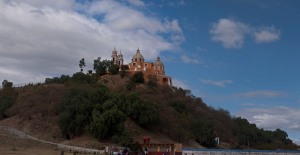
The church is called Nuestra Senora de los Remedios and it is sitting on top of the Pyramid which is 66m high and 350m on each side. The pyramid was constructed between 200 BC and 800 AD.

There are a number of tunnels through the pyramid that have been excavated and that are open to the public. However we arrived to be told that there had been a tunnel collapse and that they were closed.

On climbing the pyramid to see the church we bought some fried grasshoppers (chapulines) from a local vendor. Can’t say I was too enamoured with them – they were a bit like salty, crunchy rice crackers. We did choose the non-spicy ones though.

There is a campground in Cholula which is only about 20 minutes walk from the pyramid which made a convenient place for us to spend the night.
https://fromatob.org/2012/01/24/cholula-the-great-pyramid/
|
|
|
|
|
|
|
|
| Reply |
Message 10 of 22 on the subject |
|
|
|
| Reply |
Message 11 of 22 on the subject |
|
|
|
| Reply |
Message 12 of 22 on the subject |
|
|
|
| Reply |
Message 13 of 22 on the subject |
|
|
|
EN VENECIA ESTA EL SECRETO
RAMERA=$ =SERPIENTE= SABADO= SABIDURIA= LETRA S= SOPHIA=SNAKE =SERPENT
S=SERPIENTE
ES IMPOSIBLE SABER LA VERDAD SI USTED NO ESTUDIA EL CATOLICISMO
LA SERPIENTE SIEMPRE SE MUERDE LA COLA.
|
|
|
|
|
 |
| The seaside view of El Castillo at Tulum |
For thousands of years, the largest structures on Earth were pyramids: the Great Pyramid of Khufu in Egypt, is the only one of the Seven Wonders of the Ancient World still remaining.
Pyramids are being constructed since Upper Paleolithic, about 45,000-10,000 years ago to modern days. The first humans used mammoths’ bones, stones and/or pieces of wood as construction material for their pyramid-like structures.
Pyramids are the most stable constructions, and man learned how to imprint some information on it, writing on its walls, or even by the way they’ve constructed it.
Why were pyramids built?
Basically, ancient Egypt pyramids came from the mastabas, tombs used for the burials of pharaohs and their queens.
The first pyramid was made by stacking a mastaba on top of a slightly larger one. Mastabas were relatively low, rectangular, flat-roofed, roughly bench-shaped burial mounds for the pre-Dynastic pharaohs or nobility. Mastabas, which were made of mud brick or stone, were visible monuments, with the actual burial chamber under ground.
During the fourth dynasty, after the construction of the first pyramid, monuments were erected as a signal of prosperity. Tall, glorious, and expensive structures were built as a testament to the society that they represented, and also the rulers who lead those societies. In Egypt, pyramids were erected as a tribute to the glory of the civilization by the Nile.
Pyramids were also related to the religion of the time, Egyptian pyramids held many personal items of the deceased in preparation for his afterlife.
Some other structures in Central America were used as astronomical observatories and benchmarks.
Many have said that some pyramids are mathematical compendium incorporating all kinds of astronomical and cosmological formulas of each civilization.
Although many of these factual findings and conclusions are related to pseudoscientific research, we may consider formulas incorporated in pyramids as "intentional”.
Contrary to common beliefs, the largest pyramid by volume is not the Great Pyramid of Giza; it is the Cholula pyramid in the state of Puebla.

Known as Tlachihualtepetl (Nahuatl for "artificial mountain"), Cholula is a huge complex located in Mexico. Is the largest archaeological site of a pyramid (temple) in the New World. The pyramid stands 55 meters (180 ft) above the surrounding plain, and in its final form it measured 400 by 400 meters (1,300 by 1,300 ft). The pyramid is a temple that has traditionally been viewed as having been dedicated to the god Quetzalcoatl. The architectural style of the building was closely linked to that of Teotihuacan in the Valley of Mexico.
But of course, Egyptians achieved State-of-the art in matters of pyramids construction.
 The name behind the construction of the first pyramid was Imhotep, a priest and physician; credited with many miraculous healings.Although he achieved great fame during his lifetime, Imhotep's renown continued to grow after his death. He eventually achieved status of a god among Egyptians.He is best known today as the architect who began the "age of pyramids" in Egypt. He designed and supervised the building of the step pyramid complex at Saqqara, which is believed to be the first colossal stone edifice ever built, but ancient Egypt’s chief attraction still the Great Pyramid of Giza.It has been said that the dimensions of the Great Pyramid of Giza incorporate measurements from which the Earth's size and shape can be calculated, as well as the distance between the Earth and the moon and the distance between the Earth and the sun.The Great Pyramid of Giza, also called Khufu’s Pyramid or Cheops was built entirely of limestone, and is considered an architectural masterpiece. It contains around 1,300,000 blocks ranging in weight from 2.5 tons to 15 tons and is built on a square base with sides measuring about 230 m (755 ft), covering 13 acres. Its four sides face the four cardinal points precisely and it has an angle of about 51 degrees. The original height of the Pyramid was c.146.5 m (488 ft), but today it is only 137 m (455 ft) high, the 9 m (33 ft) that is missing is due to the theft of the fine quality limestone covering, or casing stones to build houses and Mosques in Cairo.Find here some nice statistics about the Pyramid of Khufu:- The sides of all three of the Giza pyramids were astronomically oriented to be north-south and east-west within a small fraction of a degree; The name behind the construction of the first pyramid was Imhotep, a priest and physician; credited with many miraculous healings.Although he achieved great fame during his lifetime, Imhotep's renown continued to grow after his death. He eventually achieved status of a god among Egyptians.He is best known today as the architect who began the "age of pyramids" in Egypt. He designed and supervised the building of the step pyramid complex at Saqqara, which is believed to be the first colossal stone edifice ever built, but ancient Egypt’s chief attraction still the Great Pyramid of Giza.It has been said that the dimensions of the Great Pyramid of Giza incorporate measurements from which the Earth's size and shape can be calculated, as well as the distance between the Earth and the moon and the distance between the Earth and the sun.The Great Pyramid of Giza, also called Khufu’s Pyramid or Cheops was built entirely of limestone, and is considered an architectural masterpiece. It contains around 1,300,000 blocks ranging in weight from 2.5 tons to 15 tons and is built on a square base with sides measuring about 230 m (755 ft), covering 13 acres. Its four sides face the four cardinal points precisely and it has an angle of about 51 degrees. The original height of the Pyramid was c.146.5 m (488 ft), but today it is only 137 m (455 ft) high, the 9 m (33 ft) that is missing is due to the theft of the fine quality limestone covering, or casing stones to build houses and Mosques in Cairo.Find here some nice statistics about the Pyramid of Khufu:- The sides of all three of the Giza pyramids were astronomically oriented to be north-south and east-west within a small fraction of a degree; - Pi - Pi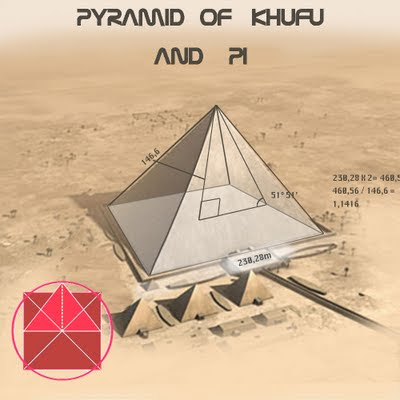 The pyramid of Cheops have a base length of 230,28 m, and a height of 146.6 m. If you take two times the base length, and divide this by the height, you get a value of Pi "3,14161..." the mathematical constant whose value is the ratio of any circle's circumference to its diameter;- Golden Ratio – Phi The pyramid of Cheops have a base length of 230,28 m, and a height of 146.6 m. If you take two times the base length, and divide this by the height, you get a value of Pi "3,14161..." the mathematical constant whose value is the ratio of any circle's circumference to its diameter;- Golden Ratio – Phi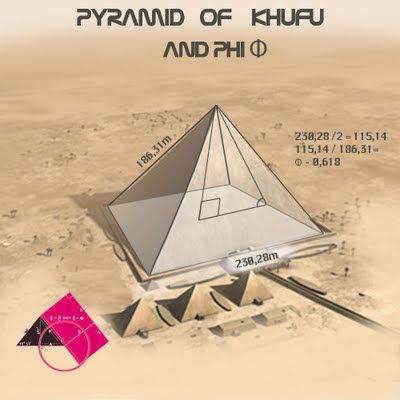 We could also find Golden Section (1:1.618), a unique ratio (or relationship between parts) that seems to be preferred by nature as the best geometry for growth, energy conservation, elegance and has some fundamental relationships to the platonic solids. Al we have to do is divide the length of the base (230.28m) by 2 and then divide it by the apothem (the altitude of a face, from ground to the top);- Center of Earth We could also find Golden Section (1:1.618), a unique ratio (or relationship between parts) that seems to be preferred by nature as the best geometry for growth, energy conservation, elegance and has some fundamental relationships to the platonic solids. Al we have to do is divide the length of the base (230.28m) by 2 and then divide it by the apothem (the altitude of a face, from ground to the top);- Center of Earth The Pyramid lies in the center of gravity of the continents. It also lies in the exact center of all the land area of the world, dividing the earth's land mass into approximately equal quarters.The north-south axis (31 degrees east of Greenwich) is the longest land meridian, and the east-west axis (30 degrees north) is the longest land parallel on the globe. There is obviously only one place that these longest land-lines of the terrestrial earth can cross, and it is at the Great Pyramid! This is incredible, one of the scores of features of this mighty structure which begs for a better explanation.- Perfectly placed stonesThe average casing stone on the lowest level was 5 ft. long by 5 ft. high by 6 ft. deep and weighed 15 tons. The casing stones weighing as much as 20 tons were placed with an accuracy of 5/1000ths of an inch, and an intentional gap of about 2/100ths of an inch for mortar;- From far awayHigh quality limestone was used for the outer casing, with some of the blocks weighing up to 15 tones. This limestone came from Tura, about 8 miles away on the other side of the Nile. Granite quarried nearly 500 miles away in Aswan with blocks weighing as much as 60-80 tones, was used for the portcullis doors and relieving chambers;- Chambers above ground levelThe Great Pyramid is the only pyramid to have chambers above ground level. The Pyramid lies in the center of gravity of the continents. It also lies in the exact center of all the land area of the world, dividing the earth's land mass into approximately equal quarters.The north-south axis (31 degrees east of Greenwich) is the longest land meridian, and the east-west axis (30 degrees north) is the longest land parallel on the globe. There is obviously only one place that these longest land-lines of the terrestrial earth can cross, and it is at the Great Pyramid! This is incredible, one of the scores of features of this mighty structure which begs for a better explanation.- Perfectly placed stonesThe average casing stone on the lowest level was 5 ft. long by 5 ft. high by 6 ft. deep and weighed 15 tons. The casing stones weighing as much as 20 tons were placed with an accuracy of 5/1000ths of an inch, and an intentional gap of about 2/100ths of an inch for mortar;- From far awayHigh quality limestone was used for the outer casing, with some of the blocks weighing up to 15 tones. This limestone came from Tura, about 8 miles away on the other side of the Nile. Granite quarried nearly 500 miles away in Aswan with blocks weighing as much as 60-80 tones, was used for the portcullis doors and relieving chambers;- Chambers above ground levelThe Great Pyramid is the only pyramid to have chambers above ground level. The arrangement of the pyramids is a disputed representation of the Orion constellation. Hancock and Bauval in their book explain that the ‘air’ shafts inside the Great Pyramid aligned to the stars in the Belt of Orion and the pole star around 2500 BC.  The southern shaft from the Queens Chamber aligned with the star Sirius at its culmination point on the meridian. This star was very important to the Egyptians and was associated with the mother Goddess Isis. The southern shaft emanating from the Kings Chamber aligned with the brightest star of the Orion Belt Zeta Orionis. This star was associated with the Egyptian God of resurrection and rebirth Osiris! The northern shafts aligned to the ancient pole star Alpha Draconis (Kings Chamber) and to Beta Ursa Minor (Queens Chamber);- Indicates equinoxes The southern shaft from the Queens Chamber aligned with the star Sirius at its culmination point on the meridian. This star was very important to the Egyptians and was associated with the mother Goddess Isis. The southern shaft emanating from the Kings Chamber aligned with the brightest star of the Orion Belt Zeta Orionis. This star was associated with the Egyptian God of resurrection and rebirth Osiris! The northern shafts aligned to the ancient pole star Alpha Draconis (Kings Chamber) and to Beta Ursa Minor (Queens Chamber);- Indicates equinoxes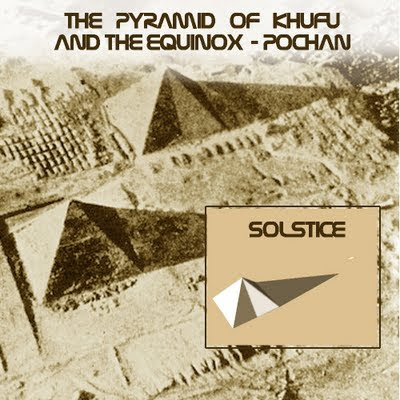 At dawn and sunset at the time of the equinoxes (around 21 March and 22 Sept), a shadow appears on the south face of the great pyramid, apparently dividing it in half, with the shaded side nearest the sun. The phenomenon occurs because the core-masonry is concave on all four faces by a yard deep. The casing stones that exist show clearly that the finished surface wasn't concave. This strange feature was first illustrated in La Description de l'Egypte in the late 1700's (Volume V, pl. 8). Flinders Petrie noticed a hollowing in the core masonry in the center of each face and wrote that he "continually observed that the courses of the core had dips of as much as ½° to 1°" (The Pyramids and Temples of Gizeh, 1883, p. 421). Though it is apparently more easily observed from the air, the concavity is measurable and is visible from the ground under favorable lighting conditions.- Pyramid power At dawn and sunset at the time of the equinoxes (around 21 March and 22 Sept), a shadow appears on the south face of the great pyramid, apparently dividing it in half, with the shaded side nearest the sun. The phenomenon occurs because the core-masonry is concave on all four faces by a yard deep. The casing stones that exist show clearly that the finished surface wasn't concave. This strange feature was first illustrated in La Description de l'Egypte in the late 1700's (Volume V, pl. 8). Flinders Petrie noticed a hollowing in the core masonry in the center of each face and wrote that he "continually observed that the courses of the core had dips of as much as ½° to 1°" (The Pyramids and Temples of Gizeh, 1883, p. 421). Though it is apparently more easily observed from the air, the concavity is measurable and is visible from the ground under favorable lighting conditions.- Pyramid power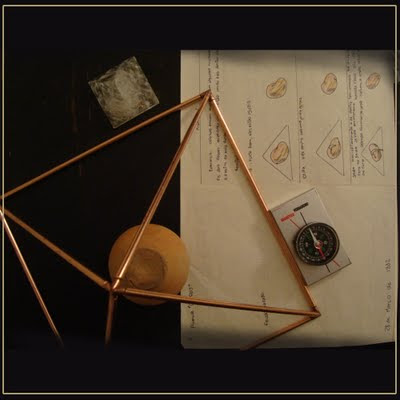
At the end of 70's Luiz Pagano father gifted him a cooper pyramidThere are many pseudoscientific theories in wich pyramids harnesses cosmic energy (or Universal Life Force Energy) and preserves it in its bosom. The idea that using small models of pyramids can improve health, improve the growth of seeds and plants, preserve food, sharpen or maintain the sharpness of razor blades, among others, was initiated in the 1930s by French hardware store owner and pendulum dowsing author Antoine Bovis.Pyramid should be oriented correctly with one of its face facing the north and the base should be perfectly aligned with the needle of a compass, Cosmic Energy gets more accumulated at 1/3rd height from the base of the Pyramid, the so called King's Chamber region.In 2005, an episode of MythBusters a test of pyramid power was performed, using pyramids built according to the specifications found in the Great Pyramid. Of course the show busted the myth, but strangely enough a half apple placed under the pyramid rots slower than the half they left in the open, force them to remake the experiment, and they didn’t perform the seed growth experiment (this one always worked in my tests as seen in my 1982 annotations caught on photo).There are lots and lots of pyramids in Egypt… And around the world:Pyramid of Chichen Itza in Mexico – one of the new 7 wonders of the World Mexico amazing historical Pyramid Chichen Itza was constructed by the pre-Columbian Maya someday among the 10th and 13th centuries AD, El Castillo served as a temple to the god Kukulkan, the Yucatec Maya Feathered Serpent deity carefully associated with the deity determine Quetzalcoatl identified to the Aztecs and different important Mexican cultures of the Postclassic period.Chichen Itza can be a step pyramid with a floor plan of squared terraces with stairways up each of the 4 facets to the temple on top. Nice sculptures of plumed serpents run down the edges of the northern staircase, and are set off by way of shadows from the nook stages at the spring and autumn equinoxes. Chichen Itza, this pyramid has 91 steps on 3 of the perimeters and 92 on the north staircase, which provides as much as 365 steps, or days of the year.The Mexican executive restored the pyramid in the 1920s and 1930s, concurrent with the Carnegie Establishment’s restoration of the Temple of Warriors. Archaeologists had been in a position to reconstruct two sides of this Chichen Itza pyramid in their entirety. Mexico amazing historical Pyramid Chichen Itza was constructed by the pre-Columbian Maya someday among the 10th and 13th centuries AD, El Castillo served as a temple to the god Kukulkan, the Yucatec Maya Feathered Serpent deity carefully associated with the deity determine Quetzalcoatl identified to the Aztecs and different important Mexican cultures of the Postclassic period.Chichen Itza can be a step pyramid with a floor plan of squared terraces with stairways up each of the 4 facets to the temple on top. Nice sculptures of plumed serpents run down the edges of the northern staircase, and are set off by way of shadows from the nook stages at the spring and autumn equinoxes. Chichen Itza, this pyramid has 91 steps on 3 of the perimeters and 92 on the north staircase, which provides as much as 365 steps, or days of the year.The Mexican executive restored the pyramid in the 1920s and 1930s, concurrent with the Carnegie Establishment’s restoration of the Temple of Warriors. Archaeologists had been in a position to reconstruct two sides of this Chichen Itza pyramid in their entirety.
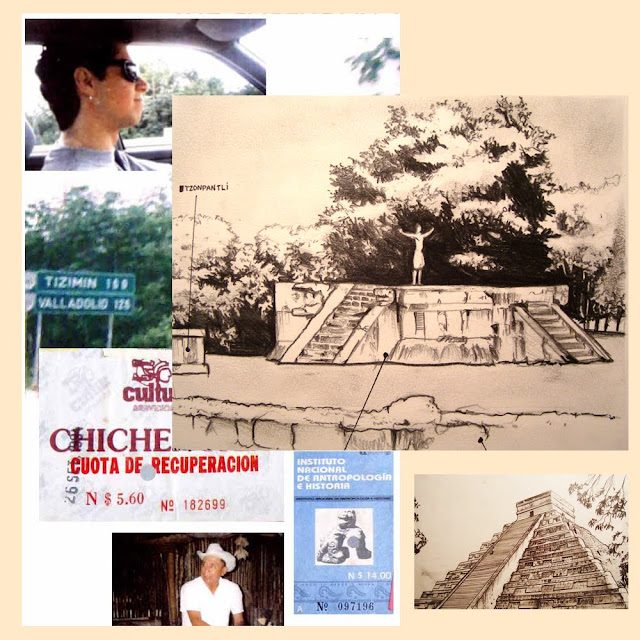 |
| Luiz Pagano travel to to Chichen Itza Sep/1994 |
Through digging from the top, they discovered another temple buried beneath the current one. Within the Chichen Itza temple chamber is a Chac Mool statue and a throne in the shape of jaguar, painted red with spots made from inlaid jade. The Mexican government excavated a tunnel from the base of the north staircase, up the in advance pyramid’s stairway to the hidden temple, and opened it to tourists.
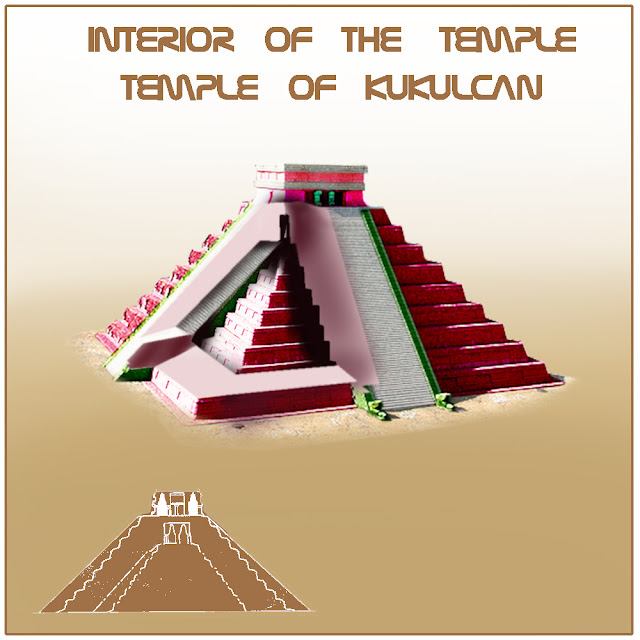 In up to date years, the National Institute of Anthropology and History (INAH), which manages the archaeological website online of Chichen Itza, has been final monuments to public access. At the same time as visitors can stroll round them, they may be able to no longer climb them or pass within their chambers. Mountaineering El Castillo used to be halted in 2006 after an 80-year old woman fell to her death. On the similar time INAH closed the general public access to the throne room.The staircases rise at an angle of 45 degrees to the horizontal, while the average inclination of the stepped pyramid itself is 53.3 degrees. The faces of the individual steps are sloped at a greater angle, approximately 73 degrees. The faces of the individual steps are sloped at a greater angle, approximately 73 degrees. - The nine main platforms of the pyramid are thought to represent the 18 months of the haab, and the 52 panels represent the number of years it takes for a calendar round date to recur.Height: 24m - top platform (+6m with the temple);The construction is 24 m high, the square base measures 55.3 m across;The temple at the top of the pyramid is 6 m high, 13.42 m wide, and 16.5 m long.The Pyramid of Kukulcan also has some facts imprinted on its structures:- The days of the yearEl Castillo's design is thought to relate to the Mayan calendar. Each of the four faces incorporates a broad, steep staircase consisting of 91 steps that ascends to the top platform. Counting the top platform as an additional step gives a total of 365 steps: 1step for each day of the year.- Indicates equinoxes - The nine main platforms of the pyramid are thought to represent the 18 months of the haab, and the 52 panels represent the number of years it takes for a calendar round date to recur.Height: 24m - top platform (+6m with the temple);The construction is 24 m high, the square base measures 55.3 m across;The temple at the top of the pyramid is 6 m high, 13.42 m wide, and 16.5 m long.The Pyramid of Kukulcan also has some facts imprinted on its structures:- The days of the yearEl Castillo's design is thought to relate to the Mayan calendar. Each of the four faces incorporates a broad, steep staircase consisting of 91 steps that ascends to the top platform. Counting the top platform as an additional step gives a total of 365 steps: 1step for each day of the year.- Indicates equinoxes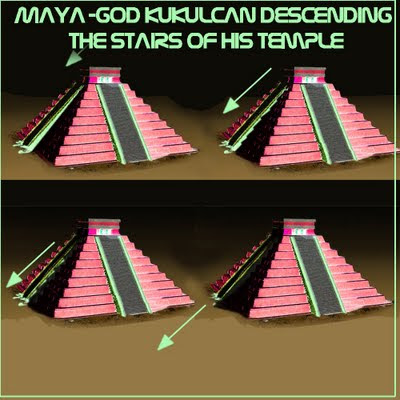 The shadow-serpent appear the slide down the steps of the north balustrade.The word for a snake's rattle, Tzab, is the same word for the Pleiades. In addition, research by Jose Diaz Bolio indicated that some Yucatecan rattlesnakes have a strange little three-dot marking in a circle near the rattlel. This symbol was read by Bolio as a solar ahau face, a symbol of the sun. Now, when the serpent shadow appears, if we wish to imagine the snake's tail, it must pierce the temple on top of the pyramid (the fifth, central direction-the zenith direction) and then it points up into the center of the sky (see diagram). Since the rattle is called tzab (Pleiades) and the three-dot ahau face design is the sun, the symbolism states unequivocally: sun and Pleiades in the zenith.This alignment doesn't occur on the equinoxes, but at Chichen Itza it occurs on May 20th in the 21st century. The point is that the pyramid "points", with this symbolism, to an astronomical alignment that occurs in a specific precessional era. As such, the Pyramid of Kukulcan is a precessional star clock constructed in stone.Pyramids of Louvre The shadow-serpent appear the slide down the steps of the north balustrade.The word for a snake's rattle, Tzab, is the same word for the Pleiades. In addition, research by Jose Diaz Bolio indicated that some Yucatecan rattlesnakes have a strange little three-dot marking in a circle near the rattlel. This symbol was read by Bolio as a solar ahau face, a symbol of the sun. Now, when the serpent shadow appears, if we wish to imagine the snake's tail, it must pierce the temple on top of the pyramid (the fifth, central direction-the zenith direction) and then it points up into the center of the sky (see diagram). Since the rattle is called tzab (Pleiades) and the three-dot ahau face design is the sun, the symbolism states unequivocally: sun and Pleiades in the zenith.This alignment doesn't occur on the equinoxes, but at Chichen Itza it occurs on May 20th in the 21st century. The point is that the pyramid "points", with this symbolism, to an astronomical alignment that occurs in a specific precessional era. As such, the Pyramid of Kukulcan is a precessional star clock constructed in stone.Pyramids of Louvre
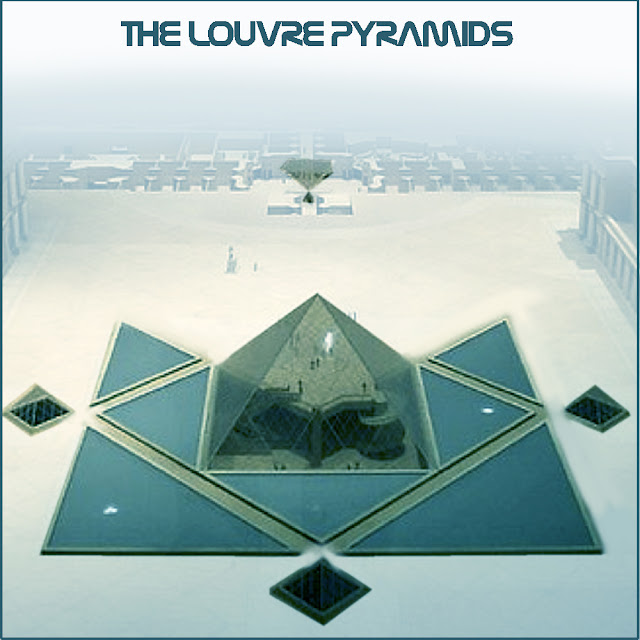 The third pyramid I would like to mention is the Louvre pyramid, a modern large glass and metal pyramid, surrounded by three smaller pyramids, in the main courtyard (Cour Napoléon) of the Louvre Palace. Was commissioned by the President of France François Mitterrand in 1984, it was designed by the architect I. M. Pei.The pyramid and the underground lobby beneath it were created because of a series of problems with the Louvre's original main entrance, which could no longer handle an enormous number of visitors on an everyday basis. Visitors entering through the pyramid descend into the spacious lobby then re-ascend into the main Louvre buildings. Several other museums have duplicated this concept, most notably the Museum of Science and Industry in Chicago.- Louvre Pyramides facts:The Louvre Pyramid is a pyramid with a square base.Height: 21.65 mLength of the base: 35 mTilt angle: 51.7 degrees;- The Legend of 666 windowsThis legend has its roots back in the 80s, when the official brochure was published, during its construction; it actually cited the number 666. But it was a mistaken number. The direction of the Louvre Museum confirmed that the complete pyramid has a total of 673 glass plates (603 diamonds and 70 triangles).David A. Shugart, in other hand, counts 689 3. It was made several statements, leading to varying results, all of them presenting more than 666; La Pyramide Inversée (The Inverted Pyramid) La Pyramide Inversée (The Inverted Pyramid) It is a magnificent skylight, considered a smaller sibling of the more famous Louvre Pyramid, yet turned upside down.The pyramid marks the intersection of two main walkways and orients visitors towards the museum entrance. Tensioned against a 30-ton, 13.3-meter square steel caisson frame, the inverted pyramidal shape in laminated glass points downward towards the floor. The tip of the pyramid is suspended 1.4 meters (a little more than 4.5 feet) above floor level. Individual glass panes in the pyramid, 30 mm thick, are connected by stainless-steel crosses 381 mm in length. After dark, the structure is illuminated by a frieze of spotlights.Directly below the tip of the downwards-pointing glass pyramid, a small stone pyramid (about one meter/three feet high) is stationed on the floor, as if mirroring the larger structure above: The tips of the two pyramids almost touch. It is a magnificent skylight, considered a smaller sibling of the more famous Louvre Pyramid, yet turned upside down.The pyramid marks the intersection of two main walkways and orients visitors towards the museum entrance. Tensioned against a 30-ton, 13.3-meter square steel caisson frame, the inverted pyramidal shape in laminated glass points downward towards the floor. The tip of the pyramid is suspended 1.4 meters (a little more than 4.5 feet) above floor level. Individual glass panes in the pyramid, 30 mm thick, are connected by stainless-steel crosses 381 mm in length. After dark, the structure is illuminated by a frieze of spotlights.Directly below the tip of the downwards-pointing glass pyramid, a small stone pyramid (about one meter/three feet high) is stationed on the floor, as if mirroring the larger structure above: The tips of the two pyramids almost touch. Brown was not the first writer to offer esoteric interpretations of the Inverted Pyramid. In Raphaël Aurillac's work Le guide du Paris maçonnique the author declares that the Louvre used to be a Masonic temple. To Aurillac, the various glass pyramids constructed in recent decades include Masonic symbolism. Aurillac sees the downward-pointing pyramid as expressing the Rosicrucian motto V.I.T.R.I.O.L. (Visita Interiorem Terrae Rectificandoque / Invenies Occultum Lapidem, "Visit the interior of the earth and… you will find the secret stone"). Another writer on Masonic architecture, Dominique Setzepfandt, sees the two pyramids as suggesting "the compass and square that together form the Seal of Solomon" (quoted in Code Da Vinci: L'enquête by Marie-France Etchegoin and Frédéric Lenoir), Brown was not the first writer to offer esoteric interpretations of the Inverted Pyramid. In Raphaël Aurillac's work Le guide du Paris maçonnique the author declares that the Louvre used to be a Masonic temple. To Aurillac, the various glass pyramids constructed in recent decades include Masonic symbolism. Aurillac sees the downward-pointing pyramid as expressing the Rosicrucian motto V.I.T.R.I.O.L. (Visita Interiorem Terrae Rectificandoque / Invenies Occultum Lapidem, "Visit the interior of the earth and… you will find the secret stone"). Another writer on Masonic architecture, Dominique Setzepfandt, sees the two pyramids as suggesting "the compass and square that together form the Seal of Solomon" (quoted in Code Da Vinci: L'enquête by Marie-France Etchegoin and Frédéric Lenoir),
Luiz Pagano at Louvre Aug 2010Whether it is built to consolidate power of the Pharaoh or to accumulate the energy of the universe, fact is that the pyramids will be always related as a symbol of mystery and power of our planet.
EVERYTHING IS CONNECTED AND THERE ARE NO COINCIDENCES |
|
|
 Primer
Primer
 Anterior
2 a 4 de 49
Siguiente
Anterior
2 a 4 de 49
Siguiente Último
Último
|
|
| |
|
|
©2024 - Gabitos - Todos los derechos reservados | |
|
|

